“US has lost 400,000 IT jobs”, “India wants WTO protection from ban on outsourcing”, “WTO plays down fear of IT offshoring” and “Outsourcing to affect 4.1m jobs by 2008” are some of the headlines we have been reading in the local newspapers and foreign news since 2004.
If these are the results of globalisation, surely it must be bad. Thus, should we resist globalisation at all costs? Before we attempt to answer this question, we need to have a better understanding of what is globalisation.
Globalisation means different things to different people around the world. It also affects different people, communities or nations of the world in different ways.
II. What is Globalisation?
Globalisation is a term that has been receiving some bad publicity. It has created fear, uncertainty and doubts in both developed and developing countries. Globalisation has resulted in individuals, in certain industries, in certain countries to lose their jobs.
The supporters of globalisation see it as the integration of economic, political and cultural systems across the world. Opponents of globalisation see it as the Americanization of world culture and U.S. dominance of world affairs via economics.
The supporters consider it to be a force for economic growth, prosperity and democratic freedom. The opponents consider it to be a force for environmental devastation, exploitation of developing countries, and the suppression of human rights.
However, the sure thing is that globalisation involves trade liberalisation. To the multi-national corporations (MNCs), globalisation is about how they continue to grow by reaching new markets and leveraging resources around the world to provide customers everywhere with great value, and shareholders with increasing returns on investments.
Hence, globalisation is about creating value on a macro scale. Since the values can be economic, political, societal and cultural in nature, different countries or nations view globalisation differently in relation to their respective values.
In the 19th century, the Chinese considered the arrival and influence of the Westerners e.g. the British, Portuguese, Spaniards and French for trade as bad for China, which later lead to the Opium Wars (1839 – 1842 and 1856 – 1860), and saw Hong Kong ceded to Britain until 1997.
Today, China’s values towards international trade and economics have changed. Together with India, they represent the top two emerging markets in the world.
Thus, globalisation is not totally new, as international trade has been in existence since man traveled the globe for e.g. Marco Polo and the Silk Road.
Thus, I can define globalisation as the acceleration and intensification of interaction and integration amongst the people, companies, and government of different nations via international trade and management.
III. Key Characteristics and Drivers of Globalisation
1.0 The key characteristics of globalisation are:
- Liberalisation of international trade
- Growth of foreign direct investments (FDI)
- Large cross-border financial flows
- Introduction of new technology
The above characteristics coupled with changes in economic and political decisions have contributed to increased competition in global markets, thus creating the enabling conditions for globalisation.
1.1 Liberalisation of international trade
International trade has expanded rapidly in the last two decades. Since the 1970's, it has grown significantly faster than the world gross domestic product (GDP) as shown in Figure 1.
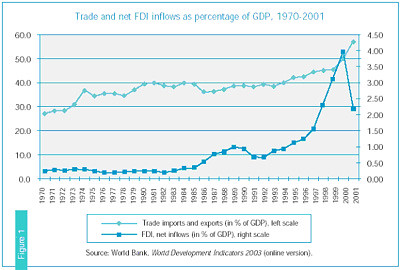
Furthermore, in the 1980's the extent of trade liberalisation, especially in developing countries began to accelerate (Figure 2).
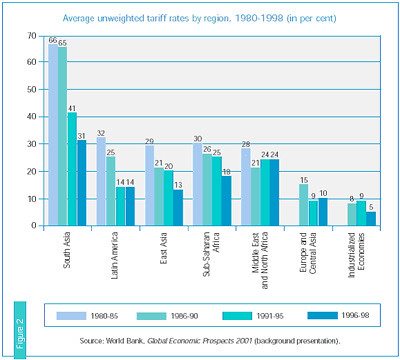
However, the trade expansion was not uniform across all countries, as the industrialised countries and a group of twelve developing countries gained the most (Figure 3).
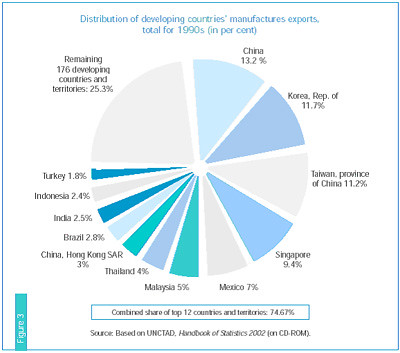
1.2 Growth of FDI
Since the 1980's, FDI also grew rapidly, both absolutely and as a percentage of GDP as shown in the previous Figure 1 and in the following Figure 4.

The number of countries adopting liberalisation measures towards attracting FDI also increased (Figure 5).
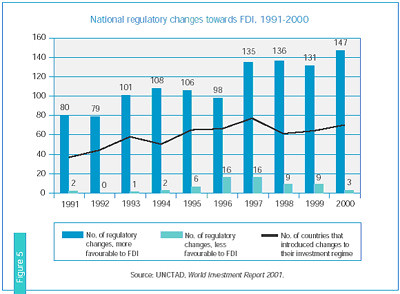
However, despite the rapid growth of FDI flows to developing countries, the investments remain concentrated in about ten countries (Figure 6).
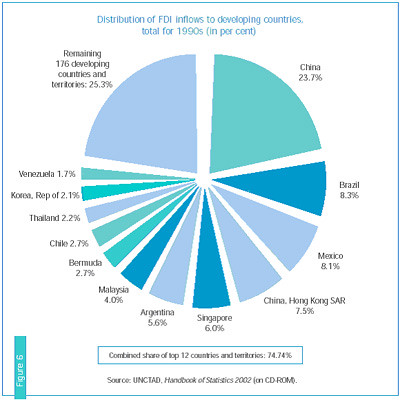
1.3 Large cross-border financial flows
The past two decades also witnessed the rapid integration of financial markets. Although the Bretton Woods system of closed capital accounts and fixed exchange rates collapsed in the early 1970's, it was not until the early 1980's that saw increased capital flows among industrialised countries.
Financial liberalisation took place in the late 1980's with increased investments in the equity markets of developed countries by investment funds, increased bank lending to the corporate sector and short-term speculative flows especially into the currency markets, and increased lending through the international bond market.
1.4 Introduction of new technology
Industrialised countries are the source of technological revolution that facilitated globalisation. The introduction of new technology changed the international competitive landscape by making knowledge an important factor of production.
Thus, the knowledge intensive and high-tech industries are the fastest growing sectors of the global economy today, and successful economic development requires countries to be able to enter and compete in these sectors. The countries must invest in education, training and the diffusion of knowledge.
2.0 The key drivers of globalisation are:
- Increasing competitive landscape: Cost and resource maximisation
- Increased adoption of information and communication technology (ICT)
- International customers
- Governments striving for greater economic growth
2.1 Increasing competitive landscape: Cost and resource maximisation
As discussed above, the liberalisation of trade, the increased FDI and cross-border financial flows, and the introduction of new technology had created the enabling conditions for globalisation.
The conditions in turn caused increased global competition among companies involved in international trade, especially the MNCs, and created the need for global business strategies, and cost and resource maximisation remains the critical factors of economic value creation.
Thus, the MNCs look towards the following to maintain their global competitiveness:
- The different locations or countries and costs of raw materials and skilled labour
- Building and maintaining economies of scale
- A developed telecommunications infrastructure
- Transportation i.e. logistics efficiency
- Outsourcing capabilities
- Tax benefits
2.2 Increased adoption of ICT
Rapid developments in ICT contributed to the acceleration of globalisation. The introduction of Internet technology and proliferation of the World Wide Web spearheaded the adoption of electronic commerce technology.
Third generation enterprise resource planning (ERP) solutions utilizing Internet and electronic commerce technology further made information, resource management and decision making easier, faster and more accurate and efficient across international boundaries.
2.3 International customers
Customers in the global market having common needs favour globalisation, and through globalisation, firms or producers/suppliers reach customers in the global market.
2.4 Governments striving for greater economic growth
Governments are also the catalysts for globalisation. Changes in or the regulation and de-regulation of trade and economic policies favouring international trade, and attracting FDI will support globalisation.
The need to ensure that the home country’s products meet international technical standards, for e.g. ISO and other regulatory compliance standards promotes globalisation.
The promotion of the home country’s products at international trade fairs and the creation of grants and funding for business expansion, ICT adoption and skills development to meet global competition encourages globalisation.
IV. Competitive Advantage of MNCs
Globalisation is constantly being driven by MNCs, initially with local competition when they began corporate life, then growing regional, and finally global in their quest to create, sustain and maximise economic value from scarce resources.
In order to be successful, a company needs to develop and sustain competitive advantage. A company needs to conduct regular environmental scanning or audits using proven methodologies such as Porter's Five Forces to evaluate and sustain their competitive advantage for continuous profitable growth.
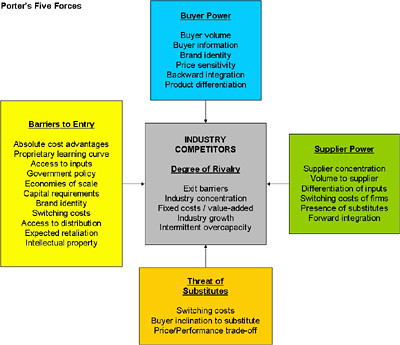
Competitive advantage can be developed from proper and careful strategic planning, execution and continued development of a company's resources and processes. The efficient and effective acquisition and utilisation of resources coupled with the company's unique capabilities can create distinctive or core competencies that are difficult for competitors to emulate.
Further adoption of one of two industry-wide strategies or focus segment strategy (Porter’s Three Generic Strategies), can enable a company to create and maintain value creation. As the company grows and expand, the strategies take on a global perspective i.e. the company evolves into a company with globalisation intentions i.e. an MNC.

V. Competitive Advantage of Nations
Globalisation does not only depend on companies adopting global strategies. In the preceding two sections, I discussed that governments also act as a driver or catalyst of globalisation.
Since governments are the custodians and managers of nations, how can I expand on the government factor in relation to their countries in the subject of globalisation?
Michael Porter argues that every country can develop and possess competitive advantage. [Porter, 1990]
Porter used a diamond-shaped diagram as the basis of a framework to illustrate the determinants of a nation’s competitive advantage. The diamond shape represents the national playing field that each country establishes for their industries.
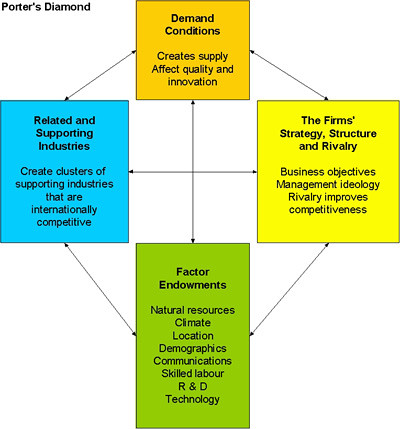
The four points of the diamond affect four aspects of national competitive advantage:
- The availability of resources and skilled labour
- Information that companies uses to decide which opportunities to pursue with the available resources and skills
- The goals of the companies
- The pressure on companies to innovate and invest
1.0 Demand Conditions
When the market for a particular product is larger locally than in foreign markets, the local companies devote more attention to that product than do the foreign companies, leading to competitive advantage when the local firms begin exporting the product. Thus, a more demanding local market leads to a national advantage that enables local companies to anticipate global trends.
1.2 Firms’ Strategy, Structure and Rivalry
Local conditions affect a company's strategy, for e.g. German companies tend to be hierarchical. Italian companies tend to be smaller and are run more like extended families. Such strategies and structures help to determine in which types of industries a nation’s companies will excel.
In Porter’s Five Forces model, low rivalry made an industry attractive. While a company prefers less rivalry, in the long term, more local rivalry is better as it puts pressure on companies to innovate and improve. More local rivalry results in less global rivalry.
1.3 Factor Endowments
A country creates its own important factors such as skilled resources and technological base. Local disadvantages in factors of production force innovation. Adverse conditions such as skilled labour shortages or scarce raw materials forces companies to develop other methods i.e. to innovate, and this leads to a national advantage.
1.4 Related and Supporting Industries
When local supporting industries are competitive, companies enjoy more cost effective and innovative inputs. This effect is further strengthened when the suppliers are also strong global competitors.
Thus, countries that are more competitive are more conducive to globalisation and can better attract FDI.
VI. The Effects of Globalisation on World Regions
The effects of globalisation on world regions are as follows:
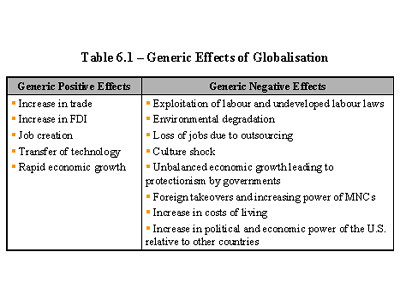
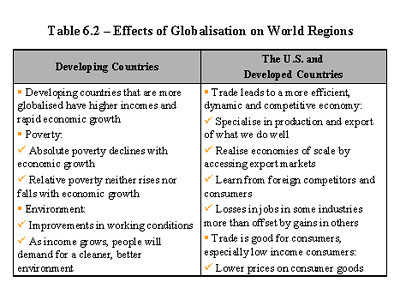
VII. The Benefits and Costs of Globalisation to Different Sectors of Society
The benefits and costs of globalisation to different sectors of society are as follows:

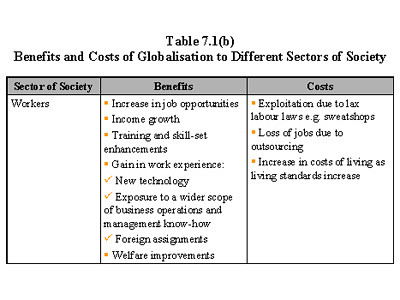
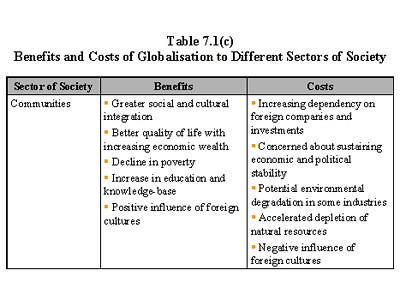
VIII. Conclusion
I can draw the following conclusions:
- Globalisation has increased the flow of money, goods, services, people and jobs across national boundaries
- The trend of globalisation continues to accelerate
- Globalisation requires an environment of geopolitical stability and a macroeconomic system to enable growth
- The full impact of globalisation goes beyond national trade surpluses and deficits
- Globalisation has tremendously impacted demand and supply with trade liberalisation
- Globalisation has also resulted in the displacement of jobs, and certain communities have had significant environmental impact
- The debate on globalisation and its impact is still ongoing
References:
Chang, Ha-Joon. (2003). Globalisation, Economic Development and the Role of the State. London, England: Zed Books
David, Fred R. (2005). Strategic Management: Concepts and Cases. (10th Edition). Upper Saddle River, NJ: Pearson Prentice-Hall
Gupta, Anil K. & Westney, D. Eleanor. (Editors). (2003). Smart Globalization: Designing Global Strategies, Creating Global Networks. San Francisco, CA: Jossey-Bass / John Wiley & Sons, Inc
Hodgetts, Richard M., Luthans, Fred & Doh, Jonathan P. (2006). International Management: Culture, Strategy, and Behavior. (6th Edition). New York, NY: McGraw-Hill / Irwin
India wants WTO protection from ban on outsourcing. (2005, June 7). Star InTech, p. 27
Outsourcing to affect 4.1m jobs by 2008. (2005, July 19). Star InTech, p. 29
Porter, Michael E. (1990). The Competitive Advantage of Nations. New York, NY: The Free Press
Rothenberg, Laurence E. (2003). "The Three Tensions of Globalization." [Electronic Version]. Globalization 101, No. 176, 2002 – 2003
Stiglitz, Jospeh E. (2003). Globalisation and its Discontents. New York, NY: WW Norton & Company
US has lost 400,000 IT jobs. (2004, September 21). Star InTech, p. 36
WTO plays down fear of IT offshoring. (2005, July 5). Star InTech, p. 27
No comments:
Post a Comment